Waldeck |
|
|
|
| Übersicht – Contents: | |
Diese Seite ist Teil des Projektes
Waldeck |
|
|
|
| Übersicht – Contents: | |
Flaggen – Flags: |
|
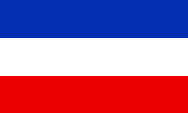 |
ca. 1830 bis/to 1849, Landesflagge (Landesfarben) – flag of the country (colours), Seitenverhältnis – ratio = 2:3, Rekonstruktion – reconstruction, Quelle/Source nach/by: Kokarde - Cockade |
 |
1848/49 bis/to 1929, Landesflagge (Landesfarben) – flag of the country (colours), Seitenverhältnis – ratio = 2:3, Quelle/Source nach/by: Wikipedia (D) |
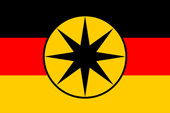 |
1848/49 bis/to 1929, vermutl. Staatsflagge – presumed official flag, Seitenverhältnis – ratio = 2:3, Quelle/Source nach/by: Wikipedia (D) |
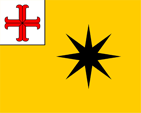 |
bis/to ca.1849, Flagge des Fürsten – flag of the Prince, Rekonstruktion – reconstruction, Seitenverhältnis – ratio = 4:5, Quelle/Source nach/by: Deutsche Wappen Rolle, Flags of the World |
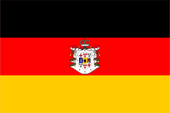 |
ca.1900–1918, Flagge des Fürsten – flag of the Prince, Seitenverhältnis – ratio = 2:3, Quelle/Source nach/by: Flags of the World, Neubecker 1933 |
|
|
|
Bedeutung/Ursprung der Flagge – Meaning/Origin of the Flag: |
|
| Die Landesfarben von Waldeck entsprechen den Farben der deutschen Trikolore des Revolutionsjahres 1848. Dies scheint ein Widerspruch zu sein, auf der einen Seite ein monarchisches Staatsgebilde und auf der anderen Seite die Flagge der Liberalen und Demokraten. Die schwarz-rot-goldene Flagge des Deutschen Bundes war nicht nur für Deutschland angenommen worden, viele Landesfürsten akzeptierten eine Verfassung und nahmen für ihr Land ebenfalls die schwarz-rot-goldene Flagge an. Die Verfassung für den Deutschen Bund wurde nie unterschrieben, denn vor allem widersetzte sich Preußen allen demokratischen Bestrebungen, und beseitigte nach und nach alle 1848 erkämpften Rechte. Die schwarz-rot-goldene Flagge wurde dort sogar verboten. In anderen Ländern des Deutschen Bundes eben nicht. Waldeck ist dafür nur ein Beispiel. |
The country's colors of Waldeck correspond to the colors of the German
tricolor in the revolution year of 1848. This seems to be a contradiction,
on the one side a monarchical state and on the other side the flag of the
liberals and democrats. The black-red-golden flag of the German Confederation was not only adoped for Germany, a lot of sovereigns accepted a constitution and adoped likewise the black-red-golden flag for their country. The constitution for the German Confederation was never undersigned, because Prussia especially opposed all democratic ambitions and eliminates step by step all in 1848 reached rights. The black-red-golden flag got there even banned. In other countries of the German Confederation just not. Waldeck is only one exemple for this. |
| Die Zeit vor 1848 liegt, was die Landesfarben und zugehörigen Flaggen angeht, weitestgehend im Dunklen. Überliefert ist eine blau-weiß-rote Kokarde, aus der sich theoretisch eine Flagge rekonstruieren ließe. Eine blau-weiß-rote Trikolore in den Farben des Wappens und dem damaligen Geschmack entprechend. Ob eine solche Flagge wirklich existierte ist nicht überliefert. |
The time before 1848 is largely hidden in the dark as far as the
national colors and flags are meant. A blue, white and red cockade has
survived, from which a flag could theoretically be reconstructed. A blue-white-red tricolor in the colors of the coat of arms and corresponding to the taste at that time. It is not known whether such a flag really existed. |
| Die Landesfarben der deutschen Länder (oft aus den Farben des Wappens abgeleitet und in Form von Kokarden, aber auch Flaggen verwendet), bildeten sich – vor allem bei den deutschen Binnenländern – erst recht spät heraus, oft in Folge der französischen Revolution und den folgenden Befreiungskriegen. In dem Zeitraum von ca. 1815 bis ca. 1830 war dieser Prozess dann in allen deutschen Ländern abgeschlossen. | The
colours of the German states are (called Landesfarben, are often derived
from the colours of the coats of arms, and used as cockades, as well as
flags), were formed – especially in the German inland countries – rather
late, often after the French Revolution and the following wars of
liberation. In the period from ca. 1815 to ca. 1830, this process was finally completed in all German states. |
| Die Flagge des Fürsten war ursprünglich einfarbig gelb mit einem schwarzen Stern in der Mitte, das Bild des Wappens des Fürstentums Waldeck, und eine weiße Oberecke mit einem roten Ankerkreuz darin, das Bild des Wappens des Fürstentums Pyrmont. Beide Fürstentümer waren ab 1631 in einer Hand und bildeten zusammen das Fürstentum Waldeck-Pyrmont, wie es mit langem Namen richtig genannt wurde. Die Flagge scheint in der Umstellungsphase auf Schwarz, Rot und Gold außer Dienst gestellt worden zu sein. Hugo G. Ströhl, der Autor des Buches "Deutsche Wappen Rolle" schreibt um 1897, dass diese Flagge nicht mehr verwendet wird, und der Fürst, auf Nachfrage am Fürstlichen Hof, keine besondere Flagge mehr verwenden würde, lediglich die Landesfarben Schwarz, Rot und Gold. Nach anderen Quellen (Ottfried Neubecker, 1933) scheint um 1900 eine neue Fürstenstandarte eingeführt worden zu sein, eine (wie die Landesflagge) horizontal gestreifte Flagge in Schwarz, Rot und Gold jedoch erscheint im mittleren roten Streifen das mittlere Wappen des Fürstentums. |
The flag of the prince was originally monochrome yellow with a black
star in the middle, the image of the coat of arms of the Principality of
Waldeck, and a white upper corner with a red anchor-cross in it, the image
of the coat of arms of the Principality of Pyrmont. Both principalities were
in one hand from 1631 and formed together the principality of
Waldeck-Pyrmont, as it was called right with a long name. The flag appears to have been decommissioned in the transition phase to black, red and gold. Hugo G. Ströhl, the author of the book "Deutsche Wappen Rolle", writes around 1897 that this flag is no longer used and that the prince, on request at the princely court, would no longer use a special flag, only the national colors black, red and gold. According to other sources (Ottfried Neubecker, 1933) a new princely standard seems to have been introduced around 1900, a (like the national flag) horizontally striped flag in black, red and gold but in the middle red stripe appears the middle coat of arms of the principality. |
| Die schwarz-rot-goldene Flagge mit dem Waldecker Stern in der Mitte ist überliefert und noch heute im Museum zu bewundern. Dass es sich um ein Unterscheidungsmerkmal handelt, um vielleicht die Dienstflagge (von Ämtern und Behörden verwendet) von den allgemein gebräuchlichen Landesfarben zu unterscheiden, kann nur vermutet werden. | The black, red and golden flag with the Waldeck Star in the middle has been handed down and can still be admired in the museum today. It can only be assumed that it is a distinguishing feature, perhaps to differentiate the official flag (used by offices and authorities) from the common colors of the country (Landesfarben). |
| Quelle/Source: Volker Preuß, Flags of the World, Deutsche Wappen Rolle, Jens Hild | |
Wappen – Coat of Arms: |
|
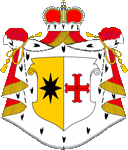 |
bis/to 1918, Kleines Wappen Fürstentum Waldeck-Pyrmont – lesser coat of arms of the Principality of Waldeck-Pyrmont, Quelle/Source nach/by: Deutsche Wappen Rolle |
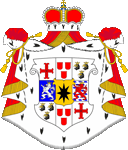 |
bis/to 1918, Mittleres Wappen Fürstentum Waldeck-Pyrmont – middle coat of arms of the Principality of Waldeck-Pyrmont, Quelle/Source nach/by: Flags of the World, Neubecker 1933 |
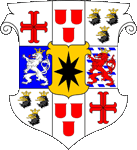 |
bis/to 1918, Schild des großen Wappens des Fürstentums Waldeck-Pyrmont – shield of the greater coat of arms of the Principality of Waldeck-Pyrmont, Quelle/Source nach/by: Deutsche Wappen Rolle |
Bedeutung/Ursprung des Wappens – Meaning/Origin of the Coat of Arms: |
|
| Die zentralen Elemente der Heraldik des Fürstentums Waldeck sind ein schwarzer Stern auf Gold, das Bild des Wappens des Fürstentums Waldeck, und ein rotes Ankerkreuz auf Silber, das Bild des Wappens des Fürstentums Pyrmont. Beide Fürstentümer waren ab 1631 in einer Hand und bildeten zusammen das Fürstentum Waldeck-Pyrmont, wie es mit langem Namen richtig genannt wurde. |
The central elements of the heraldry of the Principality of Waldeck are a black
star on gold, the image of the coat of arms of the Principality of Waldeck,
and a red anchor-cross on silver, the image of the coat of arms of the
Principality of Pyrmont. Both principalities were in one hand from 1631 and formed together the principality of Waldeck-Pyrmont, as it was called right with a long name. |
| Das große Wappen (Wappenmantel mit Krone, Schild mit Schildhaltern und 5 Helmen mit Helmkleinodien und Helmdecken, Spruchband) zeigte einen zweimal gespaltenen und zweimal geteilten Schild, mit einem aufgelegten goldenen Herzschild mit dem Waldecker Stern. Das erste und neunte Feld zeigten das Ankerkreuz von Pyrmont, im zweiten und achten Feld erschienen drei rote Schildchen auf Silber (Grafschaft Rappoltstein), das dritte und siebente Feld zeigten auf Silber drei golden bekrönte schwarze Adlerköpfe (Herrschaft Hohenack), das vierte Feld zeigte auf Blau einen golden bekrönten silbernen Löwen (Herrschaft Tonna, Grafschaft Gleichen) und das sechste Feld zeigte auf silbernem, mit blauen Schindeln belegten Grund einen golden bekrönten roten Löwen (Herrschaft Geroldseck). Das mittlere Wappen zeigte Wappenmantel mit Krone und Schild des großen Wappens, das kleine Wappen zeigte Wappenmantel mit Krone und einem gespaltenen Schild mit der Heraldik von Waldeck und Pyrmont. |
The greater coat of arms (mantle with crown, shield with shield holders and
5 helmets with crests and mantling, motto-banner) showed a shield that was
twice parted per pale and twice parted per fess, with a golden heart-shield
with the Waldeck Star on it. The first and ninth fields showed the anchor-cross of Pyrmont, in the second and eighth field appeared on silver three red escutcheons (County of Rappoltstein), the third and seventh fields showed on silver three golden-crowned black eagle-heads (Dominion of Hohenack), the fourth field showed on blue one golden-crowned silvery lion (Dominion of Tonna, County of Gleichen) and the sixth field showed on silvery background covered with blue shingles a golden-crowned red lion (Dominion of Geroldseck). The middle coat of arms showed the mantle with crown and the shield of the greater coat of arms, the lesser coat of arms showed the mantle with crown and a parted per pale shield with the heraldry of Waldeck and Pyrmont. |
| Quelle/Source: Deutsche Wappen Rolle, Volker Preuß | |
Kokarde – cockade: |
|
 |
1807–1848, Kokarde – cockade |
 |
1848–1919, Kokarde – cockade |
| Ab 1807 zeigte die Kokarde die von den Farben des Wappens abgeleitete Farbkombination Blau-Weiß-Rot. Trotz des sehr französischen Aussehens wurden die Farben auch nach dem Übertritt Waldecks auf die Seite der Alliierten im Jahre 1813 unverändert gelassen. Im Revolutionsjahr von 1848 wurden die Kokarde und auch die Flagge auf Schwarz-Rot-Gold abgeändert (die jedoch auch dem Wappen entnommen sind) und bis zum Ende des Landes im Jahre 1929 konsequent beibehalten. | From 1807 the cockade showed the color-combination of blue-white-red, derived from the colors of the coat of arms. Despite the very French appearance, the colors were left unchanged even after the crossing Waldecks on the side of the Allies in the year 1813. In the revolutionary year of 1848, the cockade and also the flag were changed to black-red-gold (which are also derived from the coat of arms) and consistently maintained until the end of the country in the year 1929. |
|
Quelle/Source:
Jürgen Kaltschmitt, nach P. Bunde, Brigadeuniformtafel Nr. 235, Herzogenrath 2010 |
|
|
Lesen Sie hier: Hintergründe, Geschichte und Fakten zum Thema "Kokarden". |
 Kokarde / Cockade |
read here: Informations, history and facts about the theme "Cockades". |
Zahlen und Fakten – Numbers and Facts: |
|
|
|
|
|
|
|
|
|
|
|
Geschichte: |
|
1189 · die Grafen von Schwalenberg erwerben die Burg Waldeck 1631 · Angliederung der Grafschaft Pyrmont 1712 · Erhebung der Grafschaft zum Fürstentum 1807 · Beitritt zum Rheinbund 1815 · Beitritt zum Deutschen Bund 1866 · im Bruderkrieg auf Seiten Preußens, Beitritt zum Norddeutschen Bund, Preußen übernimmt die Verwaltung des Landes 1871 · Beitritt zum Deutschen Reich 1918 · Sturz der Monarchie in Preußen, Schaffung des Freistaats Waldeck 30.11.1921 · Angliederung des Gebiets der ehemaligen Grafschaft Pyrmont an die preußische Provinz Hannover 01.05.1929 · Angliederung des restlichen Freistaats Waldeck an die preußische Provinz Hessen-Nassau, Waldeck erlischt |
History: |
| 1189 · the Counts of Schwalenberg purchase the castle of Waldeck 1631 · annexation of the county of Pyrmont 1712 · elevation of the county to a principality 1807 · joining to the Rhine Confederation 1815 · joining to the German Confederation 1866 · in the brother war on the hands of Prussia, joining to the North German Confederation, Prussia takes over the administration of the country 1871 · joining to the German Empire 1918 · fall of the monarchy in Prussia, formation of the Free State of Waldeck 30th of November in 1921 · annexation of the region of the former County of Pyrmont to the Prussian Province of Hannover 1st of May in 1929 · affiliation of the region of the former county of Pyrmont to the Prussian Province of Hessen-Nassau, Waldeck expires |
| Quelle/Source: Wikipedia (D), Brockhaus Konversationslexikon, Atlas zur Geschichte, Discovery '97, Volker Preuß |